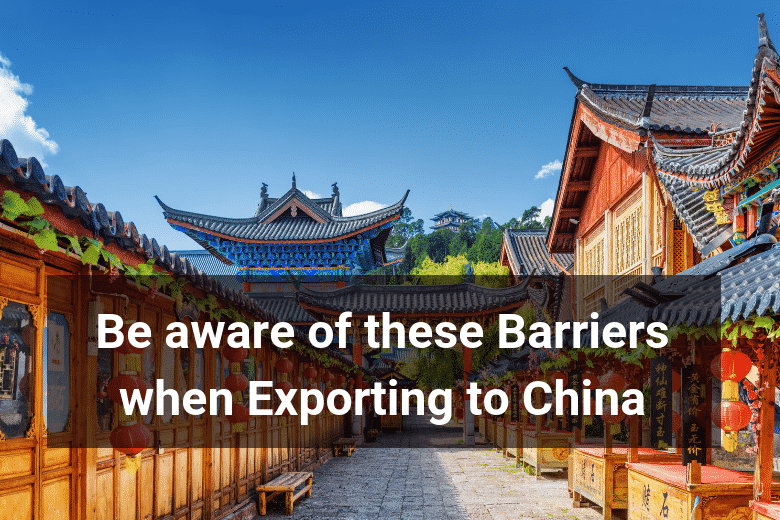With eCommerce increasing its share of the total import and export market in China, barriers are ever-changing. Recent regulatory changes and political moves by the largest economic powers of the world are proving to be prominent barriers, hindering U.S. exports and imports with China. However, a fast-developing market, such as China’s cross-border eCommerce (CBEC), is expected to result in equality fast-changing rules, regulations, and tax rates. That is not to say legislation, political moves, and taxes are the only barriers. Equally important are language and logistical barriers.
At the forefront are the growing trade tensions between the U.S and China. New U.S. tariffs on Chinese imports have prompted retaliation tariffs. A volatile political environment, causing sharp changes in demand, cost, and logistics, can be a barrier to exporting to China or any other country.
Highlighting the importance of foreign businesses being prepared to mitigate unforeseen costs in exporting, small U.S. businesses which have seen recent year-on-year growth of over 100% are seeing the immediate impact of the retaliation tariffs imposed by China. For example, Maine lobster businesses, exporting more than 80% of their goods to China, are reporting an approximate 64% decline in sales between June and July 2018 (according to WISERTrade).
Historically, China has created policies that limit market access for some foreign imported goods (e.g. higher tariffs on imported goods which are also being produced domestically, such as automobiles), while offering immense resources and support to Chinese businesses. Local governments often have an ownership stake in private companies, resulting in regulation support and a barrier to foreign businesses. However, China has recently begun relaxing tariffs with plans for further cuts.
Government Regulations
The Standing Committee of the National People’s Congress (NPC) announced on August 31, 2019 that they passed a new law which seeks to add basic protocols for Chinese eCommerce transactions and ensure additional protection for consumers. The new eCommerce regulations will take effect on January 1, 2020. For now, the new law addresses domestic related eCommerce transactions, however, CBEC is expected to be addressed later this year, specifically regarding customs clearances and quarantine requirements. The new regulations clarify which businesses are classified as eCommerce, including platform operators, third parties on the platforms, and online sellers (those doing business on other websites or social channels). The most significant change is that the law now reinforces consumer rights and recognizes the social channels under its legislation.
Customs & Clearances
Equally important are China’s non-tariff regulatory requirements, such as customs clearances. For example, in July 2018, China’s General Administration of Customs released their latest “blacklist” (Notification of Safety Risk Warning for Imported Food) of food manufacturers, exporters, and importers. 58 food companies from Europe are now subject to additional control measures against future exports to China. In an attempt to get ahead of the potential burden resulting from documentation requirements, some countries are already negotiating with China to identify acceptable documentation substitutes. The extra control measures may create a barrier to successfully exporting to China due to the extent of the documentation that could be required, such as additional data, requiring the local importer to meet with Chinese customs, or requiring letters of guarantee on packaging and labeling, all of which complicate timing and logistics.
Labelling & Packaging
China has an array of labeling and packaging requirements which are important for businesses to understand, or else risk them being barriers to entry. Goods that do not meet the labeling and packaging requirements may be refused entry to China. To mitigate any potential delay or refusal at Chinese customs, businesses should ship their products via a registered shipping agent. The documentation at customs is often the last barrier stopping a business from importing. Proof of origin, invoices to the buyer in China, packing slips, full specifications and details about the goods, and a clear product description (advantageous for this to be in Mandarin) are only some of the required documents. Furthermore, without a product description that the customs agent has little-to-no chance of misunderstanding, the goods could be delayed or refused simply because the customs agent could not categorize the goods for tax purposes.
Taxes
Tax costs, alone, may be a small business’ barrier to exporting to China. Value added tax (VAT, applied to almost all goods) and consumption tax (on some goods) are evaluated at the point of importation. The normal VAT rate ranges from 10% to 16% for certain items. Importers of certain consumer goods (e.g. tobacco, liquor and cosmetics) must pay consumption tax at a rate varying between 1% and 40%. [1] China charges tariffs on most imports ad valorem. The tariffs are calculated on the transaction price of the goods. This figure includes packing charges, freight, insurance premiums, and any other service charges incurred prior to the goods reaching the customer. Further complicating barriers to China are RQs (or two-stage tariffs, meant to grant the right to pay a lower tariff), license requirements, quotas, complex inspections, and formal certification requirements recognized by the Chinese government. Businesses exporting to China via eCommerce channels would benefit from using a logistics company with extensive experience in the region.
Communication Barrier
While English continues to grow its dominance as the preferred language of business around the world, speaking and understanding Mandarin when exporting to China is important, not only for customer relations but for logistics and passing shipments through customs. There are two common methods for foreign businesses to ship to China. First is direct shipping with a postal or courier service. In this scenario, goods are stored in a warehouse and delivered to the end buyer. The second method is using a bonded warehouse. This method results in goods being stored at a location established under Chinese customs supervision. Bonded warehouses have been the preferred method of shipment, due to its proximity to customs which, in turn, led to faster logistics. However, in 2017, a large amount of foreign businesses shifted to the direct shipping method after new eCommerce tax regulations were put in place, highlighting the importance of being prepared for quick changes to barriers.
Barriers to exporting to China will continue to ebb and flow, as expected with growing markets. Political climates will shift quickly, regulations and taxes will change and impact business, and foreign businesses looking to be successful in China’s eCommerce market will have to adapt swiftly. Being prepared for such fast-changing barriers and having a solid logistics plan will influence a company’s success in exporting to China.
Enter the Chinese Market with Floship
Instead of dealing with all these barriers yourself, you could consult a fulfillment provider, specialised in Shipping Ecommerce products directly to China. Floship is a Hong Kong based eCommerce Fulfillment Provider. We can help ship your orders to Chinese consumers, help you clear customs. We are experienced and have several partners in China to help get your goods to the doorsteps of your Chinese customers.
Let’s talk and get you a tailor-made solution for your specific business needs.

Ready To Upgrade Your Logistic Solution?
Speak to Floship ecommerce logistic consultant about improving your global support chain today




